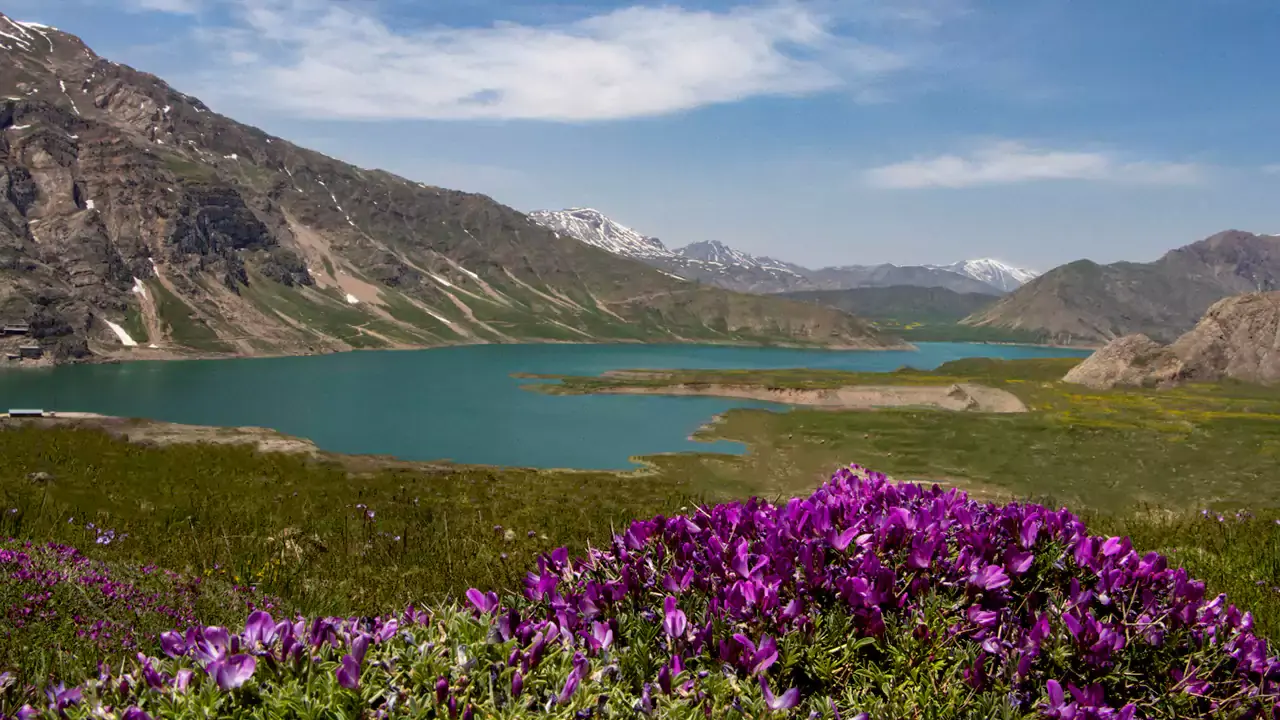Mount Damavand is the highest volcanic peak in Iran and the Middle East. It is located in northern Iran, in Mazandaran Province, within the Alborz mountain range. The mountain is part of the Larijan district of Amol County. On clear days, you can see its snow-covered peak from Tehran, Varamin, Qom, and even the Caspian Sea coastline. Its prominent, symmetrical cone shape makes it one of the most recognizable natural landmarks in Iran.
Geography and Elevation of Mount Damavand
Mount Damavand ranks as the 12th highest peak in the world in terms of prominence. The National Geological Data Center of Iran and NASA’s Earth Observatory list its height as approximately 5,670 meters (18,600 feet) above sea level. The high altitude means that the oxygen level at the summit is about half of what it is at sea level, making the climb physically demanding.
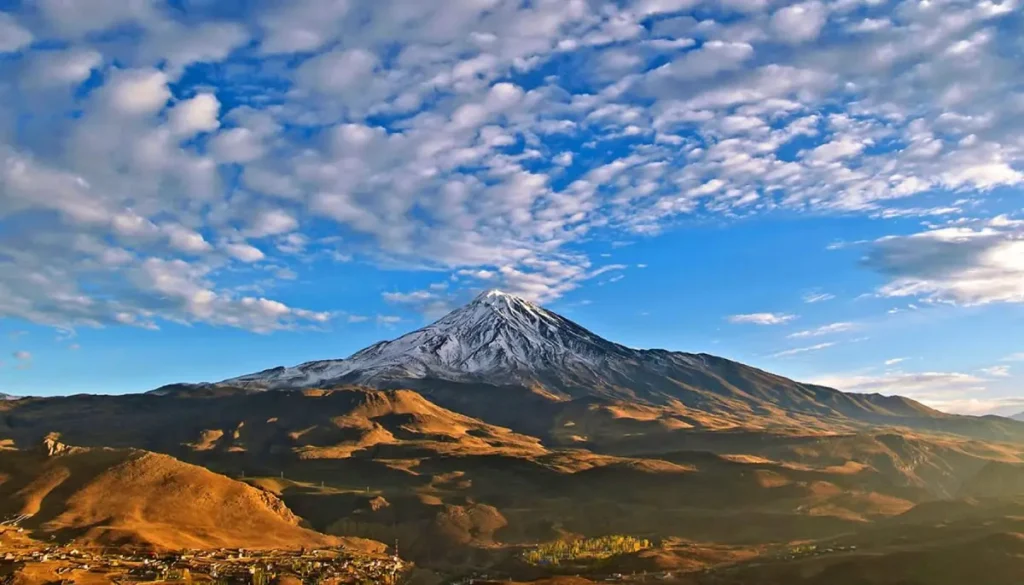
Mount Damavand’s Weather and Climate
The weather on Damavand can be extreme. In winter, temperatures can drop as low as -60°C (-76°F), while in summer, temperatures near the summit remain below freezing. The mountain receives around 1,400 millimeters of precipitation annually, mostly in the form of snow at higher altitudes. If you plan to climb, the best season is between June and September when the conditions are more stable.
How Much Rain and Snowfall Does Mount Damavand Get?
The mountain receives approximately 1,400 mm (55 inches) of precipitation annually, mostly in the form of snow at higher elevations. This heavy snowfall keeps the peak covered in ice year-round.
Mount Damavand in History
Mount Damavand has been an important part of Iranian history for centuries. Ancient Assyrians referred to it as a source of valuable minerals like lapis lazuli. During their invasions of the Iranian plateau, they recognized Damavand as part of the Median Empire’s borders.
Historical records mention an old fortress at the base of the mountain in the 8th century AD, where a Zoroastrian priest named Masmouqan and his followers lived. The Abbasid Caliphate later destroyed the fortress. During the Pahlavi era and in various periods of Iran’s history, Mount Damavand and the rising sun behind it were used as symbols of Iran.
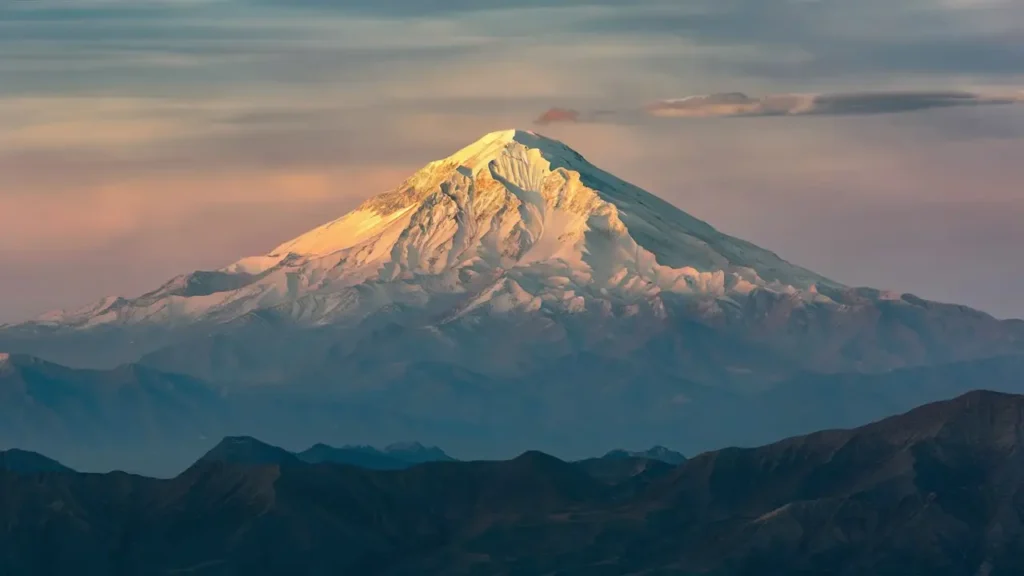
Mount Damavand in Persian Mythology and Literature
Mount Damavand plays a significant role in Persian mythology. According to legend, the mythical Persian hero Fereydun imprisoned the evil king Zahhak inside a cave on Damavand’s slopes. It is said that Zahhak will remain there until the end of time, when he will escape and be defeated by another hero. Some locals still believe that strange sounds heard from the mountain are the cries of Zahhak.
The mountain is also associated with other legendary figures like Kiumars, the first man in Persian mythology, and Arash the Archer, who shot an arrow from its peak to define the border between Iran and Turan.
Persian poets such as Ferdowsi, Naser Khosrow, and Malek o-Shoara Bahar have praised Damavand in their poetry. Ferdowsi describes the legend of Zahhak in his epic Shahnameh, while Bahar’s famous poem Damavandieh compares the mountain to an unshakable fortress.
Natural Attractions of Mount Damavand
Frozen Waterfall
One of Damavand’s most unique natural wonders is its frozen waterfall on the southern route. This seven-meter-high (23 feet) waterfall never completely melts, even in summer. During the day, sunlight causes a small amount of ice to melt, but as soon as the temperature drops in the evening, the water refreezes. The waterfall sits at an altitude of about 5,100 meters (16,700 feet), making it one of the highest in the Middle East.
Glaciers
Damavand is home to several glaciers, particularly on its northern slopes. Some of the most well-known include:
- Siyuleh Glacier (northern face)
- Dobi Sel Glacier (northern face)
- Arousak Glacier (northern face)
- Yakhar Valley Glacier (northeastern face)
- Khortab Sar Glacier
- Northwest Glacier
- Western Glacier
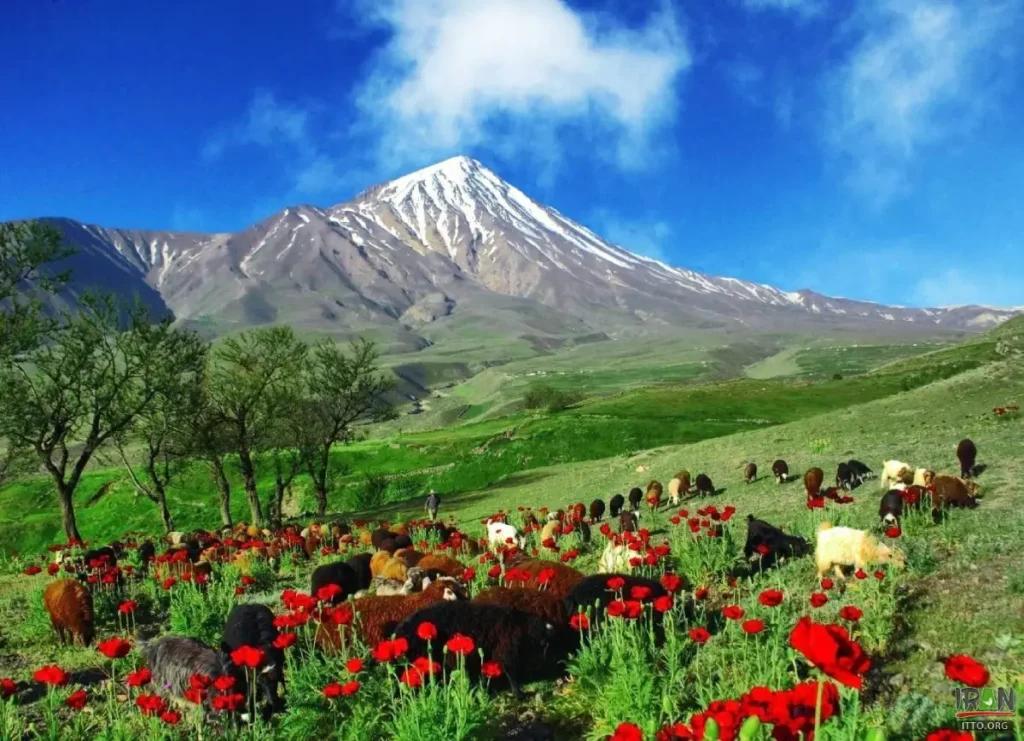
Plants
Mount Damavand has diverse plant life, including many medicinal herbs. Some plant species are named after the mountain, such as:
- Damaavand Borage
- Damaavand Yarrow
- Damaavand Sagebrush
- Damaavand Chamomile
The lower slopes (2,000-3,500 meters) are famous for fields of wild red poppies, known as Laar Poppies. Unfortunately, overgrazing, mining, road construction, and littering threaten the natural beauty of these fields.
Animals
Due to its unique location between forests in the north and desert mountains in the south, Damavand supports a variety of wildlife:
- Predators: Foxes, jackals, wolves, and bears (mostly in the west and north)
- Herbivores: Wild goats, deer, boars, rabbits
- Birds: Golden eagles, owls, partridges, woodpeckers
- Reptiles: Several types of harmless snakes, lizards, and scorpions
High-altitude areas (above 4,000 meters) have fewer large animals, but some creatures, such as wild goats, can reach elevations of up to 5,000 meters. Dangerous wildlife is rare, and venomous bites can be treated within hours.
Mount Damavand’s Recognition as a Natural Heritage Site
In 2008, Mount Damavand became Iran’s first natural landmark to be registered on the country’s National Heritage List. It was also declared a protected area in 2002 due to its ecological significance. Conservation efforts are essential to protect this iconic peak from threats like pollution, illegal hunting, and environmental damage.
Is Mount Damavand an Active Volcano?
Mount Damavand is a stratovolcano that formed during the Holocene epoch, approximately 38,500 years ago. The last major eruption is believed to have occurred around 10,000 years ago. Today, the volcano is considered semi-active. Evidence of volcanic activity includes sulfur vents and hot springs, which indicate that heat is still present beneath the mountain. The summit features a crater about 400 meters (1,300 feet) wide, covered by a permanent ice cap.
While some believe Damavand is dormant, others argue that its sulfur emissions and geothermal activity suggest it is still an active volcano. Geologists like Dr. Mehdi Zare support the view that Damavand remains volcanically active.
How to Reach Mount Damavand
You can see Mount Damavand from several cities, including Tehran, Qom, and Varamin, but to climb it, you should travel to Tehran or the nearby town of Damavand. There are four main climbing routes, each with different levels of difficulty. The southern route is the most popular and well-equipped, with shelters and campsites along the way. The famous frozen waterfall of Damavand is located on this route.
Even though there are shelters on the way, it is highly recommended to hike with an experienced local guide. The weather can change rapidly, and the high altitude can be challenging. Several mountain lodges offer accommodation, and you can also find climbing guides at the base camps.
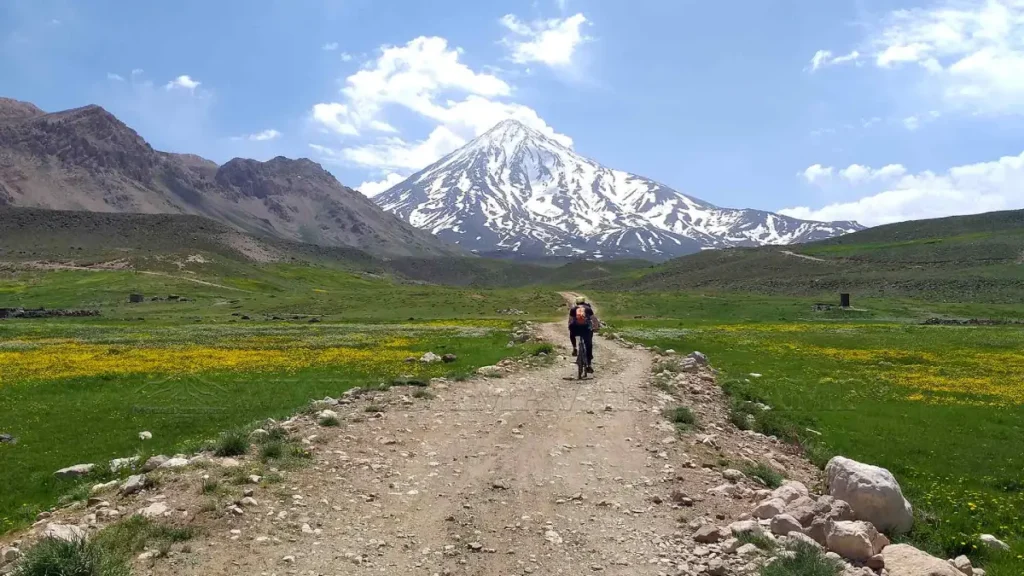
Shelters and Base Camps at Mount Damavand
Several mountain huts and shelters provide rest stops for climbers. The most used shelters include:
- Rineh Shelter (2,000m): Located near the southern route, this is a popular starting point.
- Bargah-e Sevvom Shelter (4,000m): A key stop on the southern route, offering basic accommodation.
- Simorgh Shelter (West Route, 4,150m): A stop for those climbing via the western route.
Climbing Mount Damavand
Southern Route (Easiest and Most Popular)
Start at Polour or Rineh and take a dirt road to the Goosfandsara Base Camp (3,000m). From here, it takes about 4 hours to reach Bargah-e Sevvom and another 6 hours to the summit, depending on your fitness level.
Western Route (Short but Steep)
This route begins at Vararu and passes through the Simorgh Shelter before leading to the summit. It is steep but has a shorter overall distance.
Northern Route (Longest and Most Challenging)
The hardest route with steep slopes and long stretches of ice and snow. It starts from Nandal village and passes through two glaciers before reaching the summit.
Northeastern Route
A scenic but long route that starts from Nandal village and passes through Takht-e Fereydoun shelter at 4,400 meters.
Best Time to Climb Mount Damavand
The best time to climb Damavand is from June to September when the weather is stable. Winter climbs are extremely difficult and require expert mountaineering skills.
Entry Fees and Costs
There is no official entrance fee, but if you plan to stay at a shelter, it is best to book in advance. Costs vary depending on transportation, guides, and accommodation.
How Many Days Does It Take to Climb Mount Damavand?
The duration of the climb depends on your physical fitness and the chosen route. Most climbers take two to three days:
- First day: Hike to a high-altitude shelter and spend the night.
- Second day: Acclimatization or a final ascent to the summit.
- Third day (optional): A return hike, especially for longer routes.
Altitude Sickness – Be Prepared
Damavand’s high elevation makes altitude sickness a major concern. Spending a night at 4,000 meters before ascending higher helps with acclimatization. Symptoms include headaches, nausea, and dizziness. If you feel unwell, descend immediately.
What to Expect at the Summit
The summit of Mount Damavand is a vast, rocky plateau filled with the strong smell of sulfur gas. A shallow crater sits at the top, and clouds of sulfur rise from the volcanic vents. On clear days, you can see vast landscapes stretching below, including other high peaks and glaciers.
Some climbers become emotional when they reach the summit, overwhelmed by the achievement. While the journey is physically demanding, the reward of standing on Iran’s highest point is worth every effort.
Essential Gear for Climbing Mount Damavand
Proper gear is crucial for a safe and successful climb. Here’s what you need:
- Clothing: Layered clothing, windproof and waterproof jackets, gloves, and thermal wear.
- Footwear: Sturdy, insulated hiking boots.
- Camping Gear: A warm sleeping bag, tent (if not using shelters), and a camping stove.
- Navigation & Safety: A GPS device, map, sunglasses, and sunscreen.
- Food & Water: High-energy snacks and at least 3 liters of water per day.
- First Aid Kit: Including altitude sickness medication.
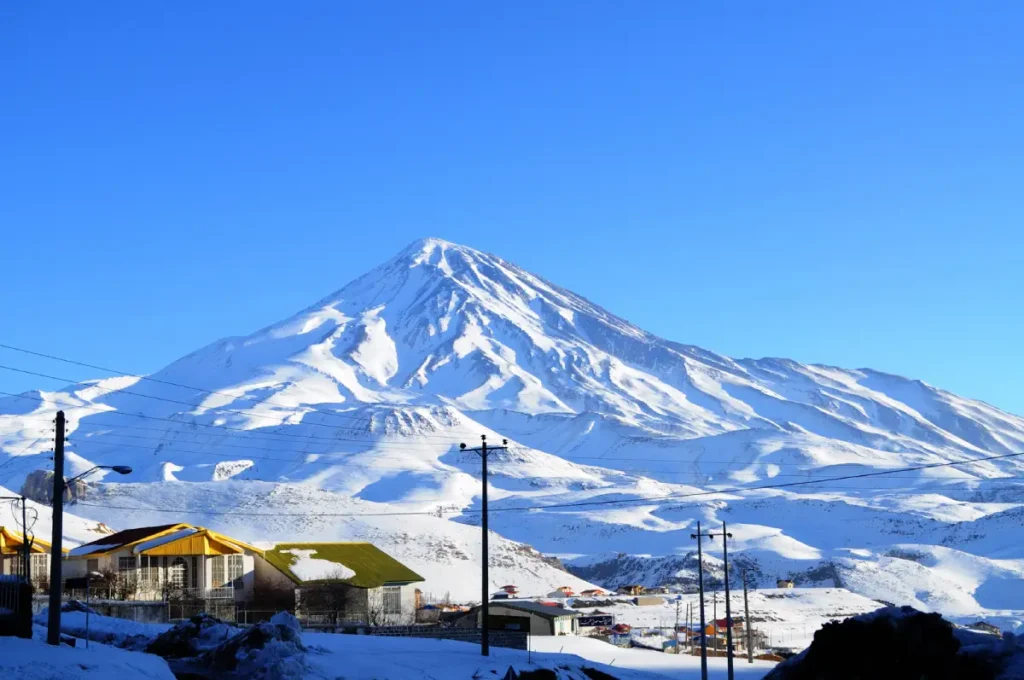
Safety Tips for Climbing Mount Damavand
- Acclimatize properly to avoid altitude sickness.
- Check the weather forecast before your climb; storms can be sudden and dangerous.
- Stick to marked trails to avoid getting lost, especially on rocky and icy sections.
- Avoid climbing alone – it’s safer to go with a guide or a group.
- Be aware of sulfur gas near the summit and avoid prolonged exposure.
Should You Climb Mount Damavand?
If you are physically prepared and have experience with high-altitude trekking, climbing Damavand is a fantastic adventure. However, it requires good planning, proper gear, and acclimatization. If you are a beginner, hiring a local guide will make your climb safer and more enjoyable.
Mount Damavand is more than just a mountain—it’s a symbol of Iran’s natural beauty and a challenge for climbers. Whether you climb for adventure, personal achievement, or simply to witness breathtaking views, Damavand offers an unforgettable experience.
Final Thoughts
Climbing Mount Damavand is more than just a hike—it’s a journey through history, nature, and personal challenge. As the highest volcano in Asia, it offers breathtaking views, unique geothermal features, and a deep connection to Persian culture and mythology. Whether you’re an experienced climber looking for a high-altitude adventure or a nature lover drawn to its beauty, Damavand provides an unforgettable experience.
Beyond the climb itself, Damavand is a symbol of strength and resilience in Iranian culture. The mountain’s legends, from the story of Zahhak to its role in Persian literature, add depth to the adventure. The journey also introduces you to the warm hospitality of local guides and villages, where you can rest, recharge, and learn more about the region’s traditions. With its challenging but rewarding ascent, the climb pushes you physically and mentally, making the summit feel even more victorious.
If you’re planning to conquer Mount Damavand, preparation is key. Choosing the right season, acclimatizing properly, and respecting the environment will make your experience smoother and more enjoyable. Whether you climb for the thrill, the scenery, or the cultural significance, Damavand is more than just a peak—it’s a once-in-a-lifetime adventure that leaves you with lasting memories.
